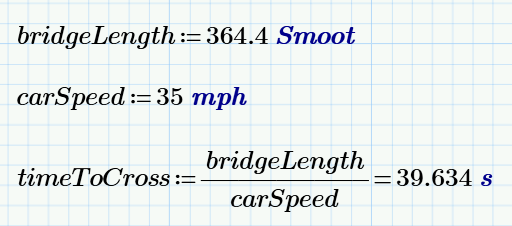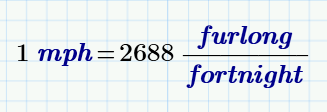The Harvard Bridge, which spans the Charles River to connect Boston and Cambridge, Massachusetts, is 364.4 Smoots long (+/- 1 ear). How long would it take me to traverse the bridge if I were going 35 mph?

Harvard bridge. Image Dvortygirl via Wikimedia commons.
That may not be an easy number to determine if you don't know how long one Smoot is. What is a Smoot anyway?
In 1958, as part of a fraternity prank at MIT, Oliver Reed Smoot was used as a measuring stick for the Harvard Bridge. He lay flat as fraternity members carried him along the bridge, marking the lengths of his body, 364.4 Smoots in total. Those measurements have become something of a legend in the area, with college students repainting the markings every year.
Interestingly, having begun his college career as a standard of length measurement himself, Oliver Smoot "went on to head both the American National Standards Institute [ANSI] and the International Organization for Standardization [ISO]" according to the plaque on the Harvard Bridge that was installed to commemorate the 50th Anniversary of the advent of the Smoot unit.
In order to answer the initial question posed, we need to know how tall Oliver Reed Smoot was in October 1958. In other words, what is the conversion factor between Smoots and miles, or Smoots and feet?
100-Smoots mark on Harvard Bridge. Image Dvortygirl via Wikimedia commons.
Of course, this problem is not relegated to Smoots. If I had given the length of the Harvard Bridge in meters, we would still need to know the conversion factor in order to determine how much time it would take me to cross the bridge. The only real difference is that meters are more well known, so it is more likely that you already know the conversion factor between meters and feet.
I, however, do not know even that conversion. Given that (a) I agree with Sherlock Holmes’ notion (found in A Study in Scarlet, by Sir Arthur Conan Doyle) that we should not crowd our brains with useless information, and that (b) Mathcad eliminates my need to use unit conversion factors, thereby rendering those factors useless to me, “I shall do my best to forget” any conversion factors.
It turns out that Mathcad doesn’t just know about meters. Mathcad also has Smoot as a built-in unit (a fun little surprise). Thus, using Mathcad, we can see what the conversion factor is from Smoots to feet-inches-fraction:

There you have it. Oliver Reed Smoot was 5 feet 7 inches in 1958, thus making the Harvard Bridge just under 0.4 mile long (+/- 1 ear, which is on average 6.30 cm).


Going back to the original problem, Mathcad makes it easy. No unit conversions necessary.

While I doubt you are using Smoots in your engineering calculations, you are still using units. And having to keep track of what units you have to use and how to convert between different units can be a waste of time and error prone.
So whether you are still using Excel for your calculations, trying out Mathcad for the first time, or using Mathcad regularly but (inexplicably) not taking advantage of its unit sensitivity, I offer the same piece of advice: Start using units in Mathcad! (Did the bold and italics help? I thought ALL CAPS MIGHT BE TOO PUSHY)
I have been subtle, I know, but you should know that I feel very strongly about this. As such, I want to give you some resources as you familiarize yourself with units in Mathcad:
I’ll leave you with this question: How many furlongs per fortnight would you have to travel in order to drive (or otherwise travel) from New York City to Boston in 4 hours? It’s easy to figure out with Mathcad.

Calculations are at the heart of engineering. PTC Mathcad is math software that lets you perform, analyze, document, and share your calculations easily.
Best of all, you can download PTC's engineering calculation software free. Try it today!